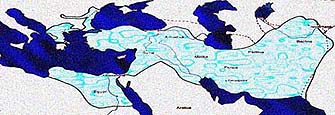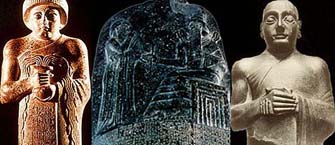The state: A political system within the cultural system
As cultures evolve into civilizations, one of the systems of social organization that typically develops and grows in complexity is government. Formal government, or the "state," is most often associated with city civilizations whose economy has developed to the point where many specializations can be supported and where there exists a level of technology in which metallurgy has been discovered.
As a part of this process of city growth (which in turn results from sustainable agriculture) and technological development, social hierarchies emerge with identifiable elites; the complexities of life in the larger community require a state organization. The power of the elite often finds expression in building projects and monumental architecture.
The full causes of state formation are not entirely understood and probably consist of a number of factors working together to create a need for more organization for a specific purpose or purposes. One important factor may be competition among human communities for space and resources as populations grow in specific regions; the groups which organize most effectively to improve their own conditions or to defend themselves gain an important advantage over their neighbors. Another factor may be specific challenges or opportunities in the environment -- for example, a dry but fertile flood plain which supports wide-scale food production when irrigated.
Above are three examples of the way early state rulers depicted themselves; these depictions give acute insights into the cultural significance involved in governmental systems. These images, all from early Mesopotamia, show how art is often put to the task of justifying the cultural meanings of the positions of those in power. How to establish that the rule of the group or individual in power is beneficial, right, and necessary -- or at least unavoidable -- is a problem for elites in all societies. In the figures at left and right, the rulers of an early city-state in Sumer are shown in quasi-religious roles. On the left, a Sumerian ruler is shown pouring a libation or sacrificial gift-offering to the gods; the symbolism, or intended cultural meaning, is that the ruler stands before the gods on behalf of the community. At right, another Sumerian ruler stands in the posture of reverent and prayerful obedience before the gods -- a similar intent to link the ruler to religion in the cultural meaning system is involved. In the center, the intent is even more explicit: Hamurabi, king of Babylon (c. 1750 BCE), stands before Shamash, the Babylonian god associated with justice, to receive the laws which govern the community. The famous code of laws associated with Hamurabi is incised on the stone just below the image. The inscription makes explicit the message in the image: the gods have called the king to establish justice and order; whoever disobeys the king disobeys the gods.
In each of these three cases, the artist -- probably at the direction of the ruler or the ruler's aides -- is attempting to establish a cultural association between the ruler's position and the values of religious sanctity. While these examples are from Mesopotamia, site of the world's earliest states, the basic ideas represented appear to be typical of early states in general.
 return to the Social Organizations Gallery
return to the Social Organizations Gallery



 return to the Social Organizations Gallery
return to the Social Organizations Gallery